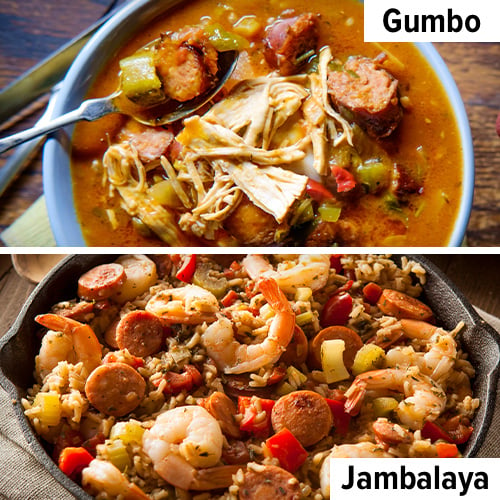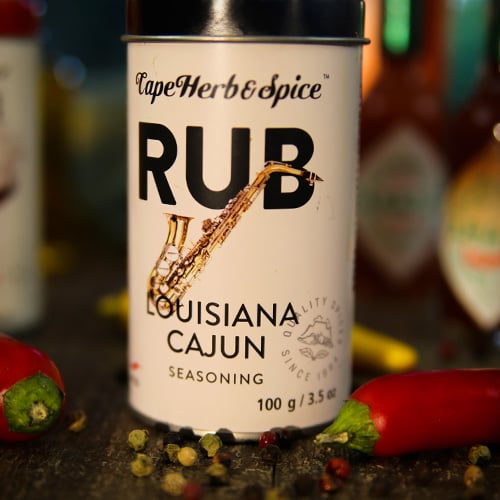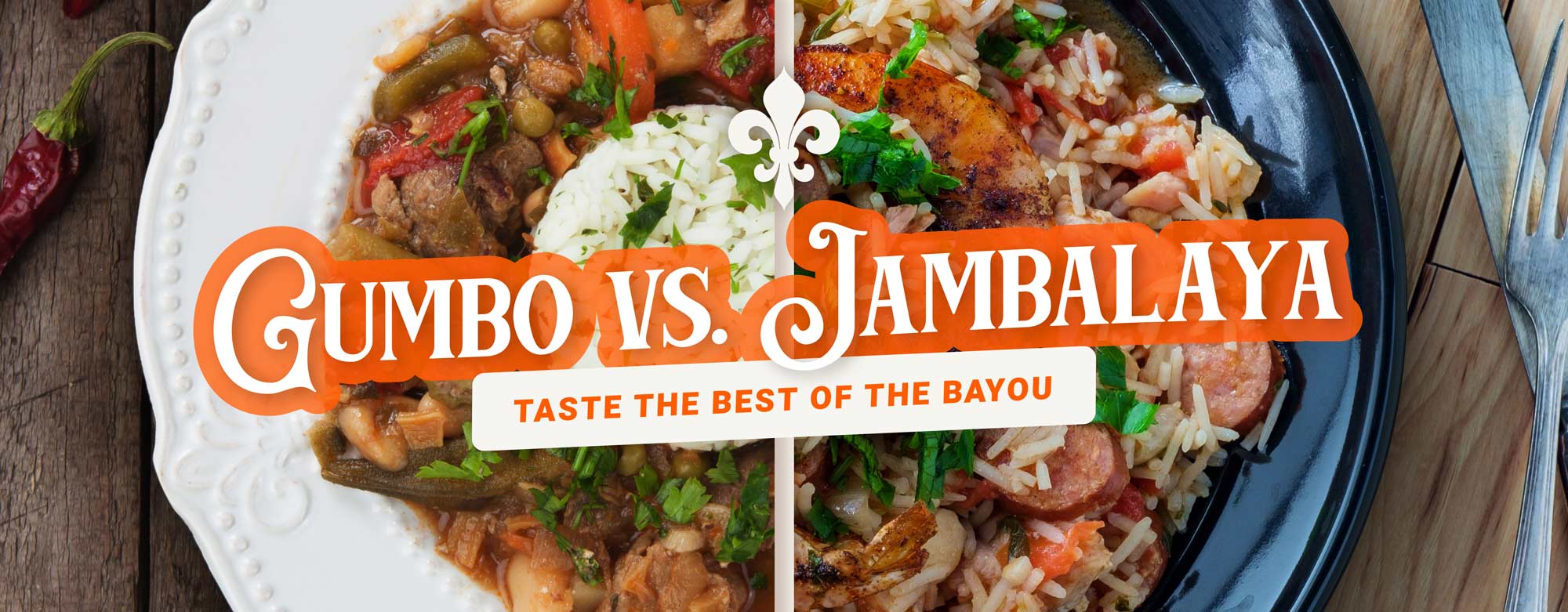Jambalaya vs Gumbo
Last updated on Nov 5, 2025Corrinn McCauleyGumbo is a roux-based, brothy stew served over rice, and jambalaya is a non-liquid, one-pot rice dish loaded with vegetables, meat, and spices. Chefs cook rice on the side and add it to each bowl before ladling in their gumbo, and they cook the rice with the other ingredients when making jambalaya. When Louisiana was owned by Spain, settlers invented jambalaya as a form of paella made with Gulf Coast ingredients, and Louisiana’s French immigrants invented gumbo. Keep reading to discover all the practical and cultural nuances between jambalaya vs gumbo and consider offering a New Orleans-inspired Mardi Gras menu.
Difference between Gumbo and Jambalaya

The most obvious differences between gumbo and jambalaya are their consistencies and the type of rice that is in or served alongside them. Gumbo is soupy and contains no rice but is served over absorbent, medium-grain white rice. Jambalaya is a moist rice-based dish made with Louisiana-grown, long-grain rice. Glutinous short-grain rice varietals turn to mush in Jambalaya recipes, but you can swap any long-grain rice for Louisiana-grown long-grain rice. A subtler difference between jambalaya and gumbo is that most gumbos are made from a roux, and jambalaya is not.
Another jambalaya vs gumbo difference is whether you add hot sauce. Slow simmered, rich, and complex gumbo needs no additional flavorings. New Orleans chefs take offense when customers add hot sauce to their gumbo, so avoid committing this faux pas while dining in The Big Easy. However, servers provide bottles of the cook’s favorite hot sauce with jambalaya orders. Most New Orleans chefs swear by Crystal.
What Is Gumbo?

A staple of southern Louisiana cuisine, gumbo is a dense soup loaded with meat, okra, and seasonings served over rice. Three traditional thickening agents create gumbo’s trademark consistency: okra, roux, or file powder (dried, crushed sassafras leaves). You will not typically see okra and file powder in the same recipe, but chefs often pair roux with the other two thickening agents. Since roux is the base of the five French mother sauces, roux-based gumbos honor Louisiana’s French heritage. File powder comes from Choctaw Native Americans, and okra reveals the influence of West African cuisine.
How to Pronounce Gumbo
Gumbo is pronounced as “Guhm - bow”.
What Is in Gumbo?
Gumbos require a thickening agent and the trinity of both Cajun and Louisiana Creole cuisines: onion, bell peppers, and celery. Most gumbos use a rich stock that is built on smoked meats such as ham hocks, bacon, or turkey necks. From there, okra and a wide variety of the chefs’ preferred ingredients give gumbo its bulk.
- What spices are in gumbo? Common gumbo spices are thyme, bay leaves, fresh parsley, Cajun seasoning, Creole seasoning, minced garlic, jalapeno, and salt.
- What kind of rice for gumbo? Medium grain rice
- What does gumbo taste like? Gumbo offers the rich flavors of a roux base, the sweet and slippery texture of okra, and/or the root beer essences of sassafras leaves. The chefs’ chosen meats add additional flavor, with spicy andouille sausage being a popular and dominating addition.
Types of Gumbo
From hearty chicken and sausage gumbo that embodies classic West African cuisine to seafood gumbos that feature the Gulf's abundant shellfish, to Lenten vegetarian gumbos, gumbo is a versatile dish. Discover the most popular types of gumbo and their predominant ingredients below.
- Chicken and Andouille Sausage Gumbo - The most popular gumbo variety is loaded with andouille sausage and chicken meat. Most chicken and sausage gumbos include a lot of okra.
- Seafood Gumbo - Seafood gumbo recipes are brimming with shrimp, crawfish, and crabmeat. They often substitute alligator sausage for andouille and/or include chunks of alligator meat. New Orleans has a love affair with both oysters and redfish, so you’ll often find them in seafood gumbo.
- Gumbo z’Herbes - Catholicism’s powerful influence on south Louisiana inspired a vegetarian gumbo that is traditionally eaten during Lent. Loaded with mustard, collard, and turnip greens, as well as other delicious vegetables, gumbo z’herbes is a flavorful stew that accommodates alternative diets.
What to Serve with Gumbo
No bowl of gumbo is complete without a small scoop of white rice at the bottom, but what side dishes should you serve with this hearty Louisiana stew? Discover the traditional items that go with gumbo.
- French Bread - Not just for po’boys, French bread is a New Orleans staple that’s perfect for sopping up gumbo broth.
- Hushpuppies - Chefs make hushpuppies by dropping cornbread batter into hot oil to produce crunchy shelled, tender-centered cornbread bites. Where did hushpuppies get their name? Cowboys threw these fried cornbread pieces to their begging dogs while saying, "Hush, puppy" and the name stuck.
- Potato Salad - Some locals scoop potato salad into their gumbo for extra creaminess, but most modern Southerners eat their potato salad on the side.
- Chargrilled Oysters - Chefs load oysters with garlic, butter, and parmesan before chargrilling them on the half-shell.
Cajun vs Creole Gumbo
Traditional Creole gumbo is tomato-based and has a soupy consistency, whereas Cajun gumbo is thick and stew-like. Cajuns and Creoles use different fat sources for their roux. Creole gumbo follows the French tradition of making a roux from butter and flour, whereas Cajun roux incorporates either lard or oil into the flour. Historically, most Louisiana Creoles had greater wealth, providing them with dairy farming abilities and access to local markets that many Cajuns lacked.
Back to TopWhat Is Jambalaya?

Jambalaya is a one-pot Louisiana rice dish inspired by Spanish paella. Chefs add their vegetables, meats, stock, and rice to a pot and simmer the mixture until the rice absorbs the liquid. Common meats for jambalaya include homemade sausage, ham, chicken, and shellfish.
Thanks to its ingredients, spices, and garnishes, jambalaya typically has a piquant flavor profile. Andouille sausage is the most common protein, and the second most popular addition is spicy, smoky Tasso. Most chefs cook with a generous pinch of cayenne pepper and encourage patrons to garnish their jambalaya with hot sauce.
How to Pronounce Jambalaya
Jambalaya is pronounced as “juhm - buh - lai - uh”.
What Is in Jambalaya?
Heavily spiced chicken, sausage, shrimp, and rice are the classic jambalaya ingredients. We explore the type of rice that is best for jambalaya, its spice blend, and its flavor profile so you can create your own.
- What spices are in jambalaya? Cayenne pepper, Cajun seasoning, garlic, Creole seasoning, black pepper, dried thyme, dried oregano, red pepper flakes
- What kind of rice for jambalaya? Long-grain rice
- What does jambalaya taste like? Jambalaya has a spicy flavor enriched by either a deep smokiness or a pleasant acidity depending on whether it follows the Cajun or Creole tradition.
What to Serve with Jambalaya
If you’re running low on time and are wondering what to serve with your jambalaya, you don’t have to serve it with anything other than hot sauce! Its balanced blend of vegetables, proteins, and carbohydrates makes jambalaya the perfect one-pot meal. Putting a warm basket of French bread on the table is always a popular choice. If you want to create a full-course meal, other classic Louisiana dishes that go with jambalaya include:
- Beignets - These famous New Orleans donuts are the perfect dessert to serve with jambalaya. Beignets are deep-fried, pate a choux dough squares served hot in a cloud of powdered sugar.
- Red Beans and Rice - Historically, Louisianians made red beans and rice on Mondays with the leftover red beans, vegetables, and pork bones from their Sunday dinners. Wealthier families added Tasso ham and sausage to their red beans and rice. These ingredients are simmered together in a pot and served over rice.
- Turtle Soup - Chefs use traditional French culinary techniques to prepare this regional Louisiana soup. Turtle soup uses a beef stock base and American snapping turtle meat, found in Louisiana swamps.
- Boudin - Louisiana boudin is a cooked sausage made from a blend of rice, pork meat, vegetables, and seasonings stuffed into a natural pork casing.
Cajun vs Creole Jambalaya
Creole and Cajun jambalaya share commonalities but diverge in execution and flavor. Both Cajun and Creole chefs add the trinity to their jambalayas (a trio of onion, celery, and bell pepper that evolved from French mirepoix), but they incorporate the trinity at different points in the cooking process. We explain what differentiates Cajun and Creole jambalaya below.
- What Is Creole Jambalaya? Creole jambalaya contains tomatoes, earning it the nickname “red jambalaya.” The holy trinity of vegetables is the first thing Creole chefs add to their pot. They simmer the trinity with their meats of choice. Seafood such as shrimp, Atlantic oysters, and crab are common in Creole jambalaya. Once cooked, chefs add tomatoes, stock, and rice to the pot and bring it to a boil. They cover the pot and cook the mixture until the rice absorbs the stock. The tomatoes give the final product a red hue. Creole red jambalaya is the variety most New Orleans restaurants serve.
- What Is Cajun Jambalaya? Cajun jambalaya, otherwise known as brown jambalaya, forgoes tomatoes and has a smokier flavor than Creole jambalaya. Cajun chefs start their jambalaya recipes by browning their meats. Once the meat caramelizes, chefs saute the meat with the trinity before pouring in their rice and stock. They simmer the mixture until the rice absorbs the stock. The browned bits of meat will dissolve, producing Cajun jambalaya’s signature brown hue. You’ll find Cajun jambalaya in rural Louisiana restaurants.
Difference between Cajun and Creole

Cajuns and Creoles are two distinct ethnic groups; together, they’ve shaped the culture and cuisine of Louisiana. Historians define Cajuns as the descendants of Acadian (French Canadian) immigrants. The term Creole describes a broad ethnic group encompassing peoples of European, African, Hispanic, and Caribbean descent. In Louisiana, the term Creole also applies to those born in New Orleans with French or Spanish ancestors.
What Is the Difference between Cajun and Creole Food?
Cuisine helps distinguish Louisiana Cajun and Creole cultures. Creole food favors tomatoes, rich sauces, and seafood. Dine at New Orleans’ old-line restaurants for Louisiana Creole dishes such as shrimp creole, roux-based gumbo, and crawfish etouffee. Cajun food is the rustic fare served in the bayous of Louisiana northwest of New Orleans, particularly in Breaux Bridge and Lafayette. Smoked meats, crawfish boils, and smoky brown jambalaya epitomize Cajun cuisine. Over the years, Cajuns and Creoles have put their unique spins on gumbo and jambalaya, creating distinct varieties that exemplify each culture's cooking style.
Cajun vs Creole Seasoning
Cajun and Creole seasoning are both spice blends from Louisiana, but they have different flavor profiles. Cajun seasoning contains paprika, cayenne pepper, white pepper, black pepper, bell pepper, and garlic powder. Creole seasoning blends oregano, bay leaf, basil, thyme, rosemary, parsley, and paprika. Since Cajun seasoning is full of peppers and Creole seasoning uses herbs, Cajun seasoning has a hot profile and Creole seasoning is reminiscent of herbes de Provence.
Back to TopGumbo vs Jambalaya FAQ

Because immigrants adopted the proteins, produce, and spices available on the bayou, many South Louisiana dishes have overlapping ingredients. Adding gumbo and jambalaya to your lineup is a low-cost way to expand your menu. To help you get started, we answer frequent questions that arise as chefs make gumbo and jambalaya:
Cajun Cooking Trinity
The trinity of Cajun and Creole cooking is a flavor base composed of equal parts onion, celery, and bell peppers chefs sweat in fat. It evolved from French mirepoix, a medley of carrots, celery, and onions. Since carrots don’t grow well in the bayou of Louisiana, French immigrants replaced carrots with bell peppers, and the trinity was born. The trinity is the foundational flavor of both gumbo and jambalaya.
What Is Roux?
A roux is a thickening agent made from equal parts flour and fat. To make a roux, mix flour into melted fat (butter, lard, oil, etc.) on the stovetop. Brown the mixture by stirring and cooking it between 350-375 degrees Fahrenheit until it reaches your preferred shade. New Orleans chefs use an espresso-hued, dark brown roux to thicken gumbo.
How to Make a Roux for Gumbo
To make a roux for gumbo, blend equal parts flour and fat in a pan on your stovetop. If you’re making a Creole gumbo, use melted butter for your roux. If you’re following a Cajun gumbo recipe, use either melted lard or oil. Cook the mixture until it turns dark brown and reaches a temperature between 350-375 degrees Fahrenheit.
How Long to Cook Gumbo
If you’re wondering how long to cook gumbo, the longer the better! Once your gumbo comes to a boil, reduce the heat and leave it to simmer for a minimum of three hours. Most authentic Cajun and Creole restaurants start their gumbo early in the morning. If you ask a Gulf Coast resident what’s in their gumbo, they’re likely to say, “12 hours of labor and lots of love.”
Etouffee vs Gumbo
While both etouffee and gumbo are roux-based, imbued with Creole seasonings, and served over rice, they are not the same thing. The term etouffee is derived from a French word meaning to smother, which is fitting for the dish since it is seafood (traditionally crawfish) smothered in a dense, tomato-based sauce. While etouffee highlights one protein, gumbo is loaded with a variety of meats, seafood, and okra. Subsequently, the consistency of etouffee is similar to bolognese sauce, and gumbo is a hearty stew. Etouffee is made with a blond roux and gumbo is made with a dark brown roux. The blond roux gives etouffee a sweeter flavor and lighter color than gumbo.
Jambalaya vs Paella
Jambalaya and paella are both one-pot rice dishes loaded with medleys of meat, seafood, and vegetables. Spices differentiate jambalaya and paella. Saffron is the main spice flavoring paella, but it is not in jambalaya. Cayenne pepper gives jambalaya a bolder flavor profile than paella. Chefs typically prepare jambalaya in a pot, whereas paella is prepared in a specialized paella pan.
From 1762 to 1801, Spain owned a majority of Louisiana. Because saffron wasn’t readily available in the bayou, Spanish settlers adopted new spices. Regional ingredients replaced old-world options. For example, jambalaya often includes okra and crawfish, which aren’t found in Spanish paella.
Jambalaya vs Etouffee
Jambalaya is a meat, vegetable, and rice dish and etouffee is a thick, seafood-loaded tomato gravy served over rice. The original etouffee recipe is crawfish etouffee, which employs crawfish stock, crawfish tails, a blond roux, the trinity, creole tomatoes, and seasonings. Jambalaya contains no rue and is rice loaded with spicy meats, seafood, seasonings, and the trinity.
What Is Tasso Ham?
A specialty of south Louisiana, butchers cure and spice Tasso ham before smoking it. Tasso ham has a spicy, salty, and smoky flavor. Conventional ham comes from a hog’s hind leg, but they make Tasso from fatty and flavorful shoulder meat. Not just for jambalaya, Tasso ham also pairs well with gumbo, grits, and gravies. Some butcher shops sell Tasso hams whole, but most chop them into easy-to-use chunks, slices, and diced pieces.

What Is Gumbo File?
Gumbo file, or file powder, is the dried and crushed leaves of the sassafras plant. Sassafras is native to the southeastern United States. Choctaw Indians cooked with sassafras long before the colonization of the Americas. You can buy gumbo file powder from a restaurant supply store.
What Kind of Sausage for Jambalaya?
Andouille is the most popular kind of sausage for jambalaya. Chorizo, alligator, or kielbasa sausage also lends well to jambalaya.
Dried or Fresh Okra for Gumbo?
You can thicken gumbo with fresh or dried okra, but pieces of okra are popular additions to toothsome gumbo.
What Is Louisiana-Style Hot Sauce?
Composed of aged cayenne peppers, vinegar, and salt, Louisiana-style hot sauce first emerged in 1928. Louisiana-style hot sauces are milder than Mexican-style hot sauces, but their high vinegar and salt contents create a tangier flavor. TABASCO® sauce, a variant of traditional Louisiana-style hot sauce, uses tabasco peppers instead of cayenne. TABASCO® sauce is spicier than other regional varieties.
Back to TopJust like jazz bands play the same songs to different rhythms, each south Louisiana chef puts a unique spin on their gumbo and jambalaya. The joy is in syncopation, the subverting of expectations. Now that you understand the difference between gumbo and jambalaya, you can take the framework of each tradition and create your signature recipe.



